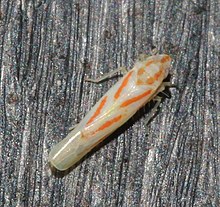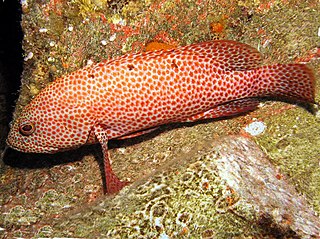
The graysby is a species of marine ray-finned fish, a grouper from the subfamily Epinephelinae which is in the family Serranidae which also includes the anthias and sea basses. It is found in the western Atlantic. It is associated with reefs and is a quarry species for commercial and recreational fisheries.

A leafhopper is the common name for any species from the family Cicadellidae. These minute insects, colloquially known as hoppers, are plant feeders that suck plant sap from grass, shrubs, or trees. Their hind legs are modified for jumping, and are covered with hairs that facilitate the spreading of a secretion over their bodies that acts as a water repellent and carrier of pheromones. They undergo a partial metamorphosis, and have various host associations, varying from very generalized to very specific. Some species have a cosmopolitan distribution, or occur throughout the temperate and tropical regions. Some are pests or vectors of plant viruses and phytoplasmas. The family is distributed all over the world, and constitutes the second-largest hemipteran family, with at least 20,000 described species.

The Auchenorrhyncha suborder of the Hemiptera contains most of the familiar members of what was called the "Homoptera" – groups such as cicadas, leafhoppers, treehoppers, planthoppers, and spittlebugs. The aphids and scale insects are the other well-known "Homoptera", and they are in the suborder Sternorrhyncha.
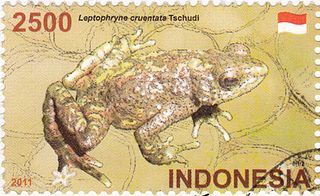
The bleeding toad, fire toad, or Indonesia tree toad is a species of "true toad", family Bufonidae, endemic to Java, Indonesia. Leptophryne javanica was included in this species prior its description as a distinct species in 2018, although the degree of differentiation between these species is low. Bleeding toad is listed as a critically endangered species due to a drastic population decline. The reasons of this decline are unclear, but the decline is consistent with chytridiomycosis, despite ambiguous identification.

The Mymaridae, commonly known as fairyflies or fairy wasps, are a family of chalcidoid wasps found in temperate and tropical regions throughout the world. The family contains around 100 genera with 1400 species.

The superfamily Membracoidea of sap-sucking true-bugs includes two of the largest families within what used to be called the "Homoptera": the leafhoppers (Cicadellidae) and the treehoppers (Membracidae). The other families in this group are quite small, and have, at various points, generally been included as members within other families, though they are all presently considered to be valid, monophyletic groups. The relict family Myerslopiidae is restricted to New Zealand and South America while the Melizoderidae consist of two genera restricted to South America. The great diversity of Neotropical taxa suggests that the group originated in that region.
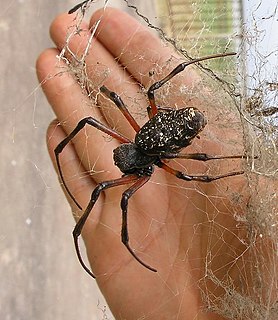
Nephilingis cruentata is an araneid spider with a strikingly red sternum.

Aster yellows is a chronic, systemic plant disease caused by several bacteria called phytoplasma. The aster yellows phytoplasma (AYP) affects 300 species in 38 families of broad-leaf herbaceous plants, primarily in the aster family, as well as important cereal crops such as wheat and barley. Symptoms are variable and can include phyllody, virescence, chlorosis, stunting, and sterility of flowers. The aster leafhopper vector, Macrosteles quadrilineatus, moves the aster yellows phytoplasma from plant to plant. Its economic burden is primarily felt in the carrot crop industry, as well as the nursery industry. No cure is known for plants infected with aster yellows. Infected plants should be removed immediately to limit the continued spread of the phytoplasma to other susceptible plants. However, in agricultural settings such as carrot fields, some application of chemical insecticides has proven to minimize the rate of infection by killing the vector.

The ochre-marked parakeet is a species of parrot native to Brazil. It is also known as blue-throated parakeet and red-eared conure in English and cotorra tiriba and perico grande in Spanish.

Curly top is a viral disease that affects many crops. This disease causes plants to become smaller in size, have shriveled petals and leaves, and are twisted and pulled out of shape. They are often caused by curtoviruses, members of the virus family Geminiviridae. This disease is important in western United States, such as California, Utah, Washington, and Idaho.

The beet leafhopper, also sometimes known as Neoaliturus tenellus, is a species of leafhopper which belongs to the family Cicadellidae in the order Hemiptera.

The red myzomela is a species of bird in the family Meliphagidae. It is found in New Guinea and New Britain. Its natural habitats are subtropical or tropical moist lowland forests and subtropical or tropical moist montane forests.
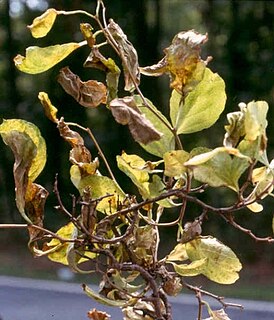
Elm yellows is a plant disease of elm trees that is spread by leafhoppers or by root grafts. Elm yellows, also known as elm phloem necrosis, is very aggressive, with no known cure. Elm yellows occurs in the eastern United States, and southern Ontario in Canada. It is caused by phytoplasmas which infect the phloem of the tree. Similar phytoplasmas, also known confusingly as 'Elm yellows', also occur in Europe. Infection and death of the phloem effectively girdles the tree and stops the flow of water and nutrients. The disease affects both wild-growing and cultivated trees.

Graphocephala coccinea is a meadow and woodland-dwelling species of brightly colored leafhopper native to North and Central America, from Canada south to Panama. Common names include candy-striped leafhopper, red-banded leafhopper, scarlet-and-green leafhopper and red-and-blue leafhopper.

Deltocephalinae is a subfamily of leafhoppers. Deltocephalinae is the largest subfamily in the family Cicadellidae and is divided into 40 tribes, comprising over 925 genera, and over 6,700 described species.

Arene cruentata is a species of small sea snail, a marine gastropod mollusc in the family Areneidae.

Bursa cruentata is a species of sea snail, a marine gastropod mollusk in the family Bursidae, the frog shells.
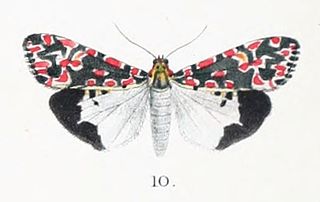
Utetheisa cruentata is a moth of the family Erebidae first described by Arthur Gardiner Butler in 1881. It is found on Mauritius in the Indian Ocean.
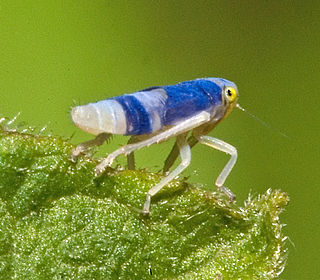
Typhlocybinae is a subfamily of insects in the leafhopper family, Cicadellidae. This is currently the second largest leafhopper subfamily based on the number of described species, but researchers believe there are so many taxa yet undescribed that it is probably the largest subfamily. Approximately 6000 species have been described to science so far.
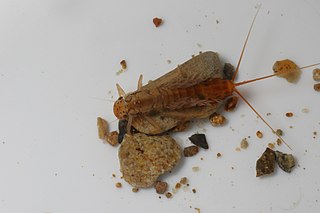
Acanthophlebia is a genus of pronggill mayflies in the family Leptophlebiidae. There is one described species in Acanthophlebia, Acanthophlebia cruentata.
